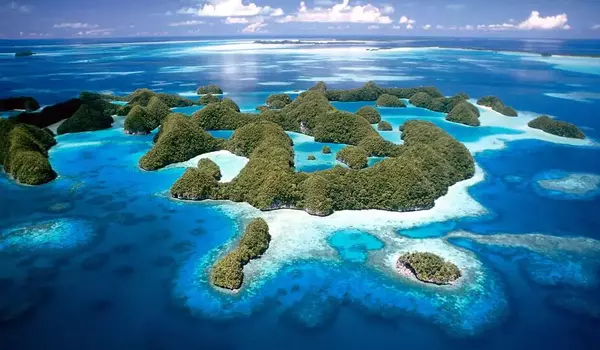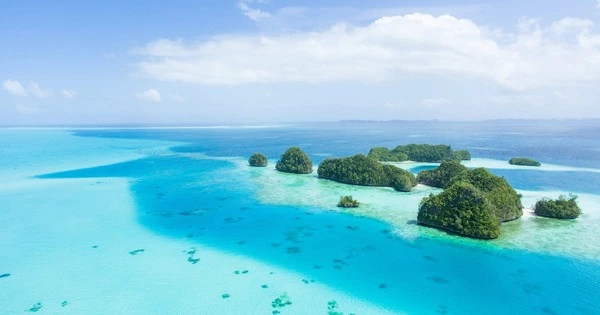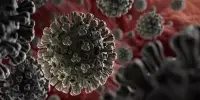Ocean warming is increasing the frequency and severity of marine heat waves, wreaking havoc on coral reefs. When the ocean becomes too hot, tropical corals, which live in symbiosis with tiny single-celled algae, exhibit a stress response known as bleaching. Marine heatwaves have caused widespread bleaching and the death of millions of corals over the last four decades. As a result, a global search for reefs that can withstand heat stress, survive future warming, and serve as a source of heat-tolerant coral larvae to replenish affected areas both naturally and through restoration is underway.
Scientists studying coral reefs in Palau, an archipelago in the western tropical Pacific, have discovered genetic subgroups of a common coral species that are remarkably resistant to the extreme heat associated with marine heatwaves. Furthermore, the scientists discovered evidence that these coral larvae are migrating from their birthing grounds deep in Palau’s lagoons to the outer reef, where they survive and grow while maintaining their heat tolerance.
Understanding the underlying mechanisms that allow these corals to tolerate heat, as well as the dispersal abilities of their larvae, will go a long way toward improving coral reef conservation and restoration efforts in the twenty-first-century ocean, according to the scientists who led the research at the Woods Hole Oceanographic Institution (WHOI).
In Palau’s main lagoon, a network of very ancient, fossilized reefs has been uplifted to form a series of mountains known as the Rock Islands. These formations slow water flow in and around them, creating localized environments in which the water temperatures are consistently higher than in other areas of Palau’s reefs.
We discovered that some of Palau’s reefs with the highest temperatures have corals that are more tolerant than expected. In addition, they are genetically distinct from the same corals found in other parts of Palau, implying that natural selection for hardier corals has occurred in these regions.
Hanny Rivera
Scientists sampled the keystone coral species Porites lobata (lobe coral) across Palau, including the Rock Islands. They took skeletal biopsies and examined the cores for stress bands, which are telltale signs of bleaching, a stress response corals have to high temperatures. They found corals from the Rock Islands bleached less during the intense 1998 heatwave than corals from other areas of the reef, indicating enhanced thermal tolerance.
Scientists then looked into the corals’ genetics and discovered four distinct lineages within the same species. Certain lineages, known as “LB” and “RD,” were much more common in the warmer Rock Islands. The scientists were able to match each coral’s genetics with its own bleaching history and discovered that fewer individuals from the “LB” and “RD” lineages bleached during 1998, indicating improved thermal tolerance.
Surprisingly, the scientists discovered that the LB lineage was not limited to the Rock Islands. They discovered some LB colonies on the cooler outer reefs as well. An examination of the bleaching histories of these colonies revealed fewer stress bands, indicating that they retained the thermal tolerance of their Rock Islands relatives.
“This suggests that the Rock Islands provide naturally tolerant larvae to neighboring areas,” the scientists write in the paper titled “Palau’s warmest reefs harbor thermally tolerant corals that thrive across different habitats,” published in Communications Biology, a journal published by Nature. “Finding and protecting such sources of thermally-tolerant corals is key to reef survival under 21st-century climate change.”

“As oceans worldwide continue to warm, corals derived from extreme habitats will be at a competitive advantage and may enable the survival of otherwise vulnerable reefs,” the authors continue. “Identifying and safeguarding natural breeding grounds of environmentally tolerant corals that can thrive under future climate conditions will be fundamental to the persistence of coral reef ecosystems worldwide in the coming decades.”
“We discovered that some of Palau’s reefs with the highest temperatures have corals that are more tolerant than expected,” said Hanny Rivera, a graduate of the MIT-WHOI Joint Program. Rivera, who carried out this research as part of her Ph.D. and postdoctoral studies, is now an associate director of business development at Ginko Bioworks. “In addition, they are genetically distinct from the same corals found in other parts of Palau, implying that natural selection for hardier corals has occurred in these regions.”
Paper co-author Michael Fox added that the study is particularly exciting because it combines coral genetics with historical records of bleaching preserved in their skeletons to shed light on how corals from extreme habitats with high-temperature tolerance can be dispersed across a reefscape. “This integrated perspective is essential for improving projections of coral communities in a warming ocean,” said Fox, who was a postdoctoral scholar at WHOI during the research for this paper. He currently is an assistant research professor in the Red Sea Research Center at King Abdullah University of Science and Technology in Thuwal, Saudi Arabia.
The Palau research is directly related to the Super Reefs initiative, which WHOI launched with The Nature Conservancy and Stanford University to identify and protect coral communities that can withstand marine heat waves.
“This work serves as the scientific foundation for the Super Reefs initiative,” said paper co-author Anne Cohen, a WHOI scientist, and Rivera’s study advisor. “The Palau research demonstrates the existence of Super Reefs while also providing actionable science knowledge to support their protection.”
Cohen pointed out that coral communities have not bleached as severely as scientists predicted based on thermal stress levels in other coral reefs, not just Palau. “When we find heat-tolerant or bleaching-resistant coral communities and protect them from other stresses that can kill them – like dynamiting, overfishing, or coastal development – they will produce millions of larvae that will travel on the currents, outside of their places of origin, as we see on Palau, and they will repopulate reefs that have been devastated by heatwaves,” she explained. “Nature is incredible. With the Super Reefs initiative, our job is to protect these thermally resilient reefs and let nature take care of the rest.”
Rivera also expressed her admiration for the Palauans’ deep appreciation, respect, and stewardship of their environment. “They have been among the forerunners in promoting marine conservation and environmental protection. It’s wonderful to know that these special reefs are in such capable hands “Rivera explained. “My greatest hope is that our research will help the Palauan people maintain a healthy marine ecosystem.”















